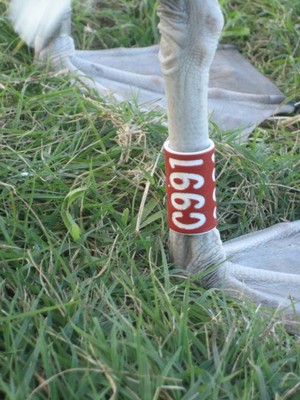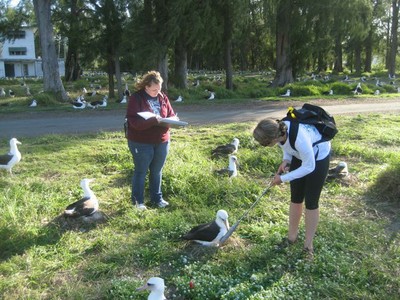Midway Atoll is home to the largest population of Laysan Albatross in the world, with close to half a million breeding pairs.
Typically, Laysan Albatross form their nests and lay their eggs in mid-November, and the eggs hatch between late January and early February. Each female lays only one egg each year, and it is common for her to nest for two or three years in a row before taking a year off.
This morning, Pete Leary, the Refuge Biologist, talked to us about albatross life cycles and reproductive success on Midway Atoll. Albatrosses fly long distances over the ocean to feed on squid, causing them to spend extended periods of time away from the nest to find food. Because of this, it is essential that they form a monogamous mating pair to provide constant care to the egg and young chicks. If one of the birds dies or does not return, the other bird will continue to care for the egg until they are forced leave to find food.
Once the chick has hatched the parent will feed the chick regurgitated squid oil, and later squid. Chicks typically fledge between five and six months after hatching, and won’t return to their nesting colony for three to five years. Once the young albatross return they participate in elaborate dances to find a mate. The paired albatross will create their first nest and lay their first egg between ages six and eight. While their lifespan is unknown, Midway Atoll is home to “Wisdom”, who is the oldest known albatross. She is estimated to be more than 60 years old. Overall, Laysan Albatross on Midway have between 60 and 80% reproductive success (the proportion of eggs laid that result in chicks that fledge), depending on the year, and an average adult survivorship of 94%.

Volunteers on Midway Atoll conduct surveys to track adult survivorship and reproductive success. The island is divided into plots that are representative of the population, with separate plots used for survivorship and reproductive success. Data collected from these plots can then be extrapolated to model the population dynamics of both species of albatross on Midway.
After Pete’s talk, we had the opportunity to divide into groups of three and join the volunteers while they conducted surveys of the reproductive plots. Reproductive plots are surveyed twice a week during nesting season. As the birds arrive and create their nest, a numbered stake is placed in the ground by each nest that falls within the plot. Each bird on the nest has a band around its ankle that is recorded to determine which bird is sitting on the nest. Once the eggs begin to hatch, the nest is noted as Adult with Egg (AE), Adult with Egg Pipping (AEP), or Adult with Chick (AC). Pipping is when there is a visible hole in the egg, meaning the chick is beginning to hatch.

While this process may seem straightforward, it can sometimes be challenging. The albatross must be encouraged to stand up to see the band number and the egg/chick. Some of the band numbers are hard to read depending on their position on the albatross foot. Many of the albatross are used to the surveying process and stand up when the surveyor approaches, but others must be coerced into standing and sometimes try to bite the surveyor.

While it may seem like half a million albatross is a lot, their population may be threatened by the tremendous amount of plastic floating in the ocean. Adults feeding at sea tend to eat plastic in addition to their normal diet of squid. While adults have the ability to expel the plastic regularly in their bolus, young chicks do not produce a bolus until they fledge. Almost all of the chicks on Midway will ingest at least some plastic before they fledge. While the plastic has not been found to directly cause death, it has indirectly been linked to death from starvation and dehydration.

Throughout our stay on Midway Atoll we have all become quite taken with the Laysan Albatross. Originally their noises kept us awake at night, but now we cannot imagine sleeping without them. We have witnessed many falls, crash landings, and face-plants during our stay here, which have only made us more enamored with the birds. It is certain that when we leave, their presence will be missed.
